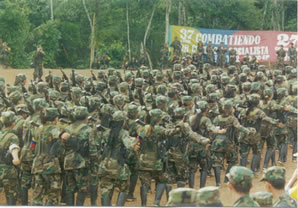Essequibo War
| Essequibo War | |||||||||
|---|---|---|---|---|---|---|---|---|---|
| Part of the Caribbean Wars (Cold War) | |||||||||
 Andean People's Army soldiers marching near Kumaka | |||||||||
| |||||||||
| Belligerents | |||||||||
|
Supported by: |
Supported by: | ||||||||
| Commanders and leaders | |||||||||
|
|
| ||||||||
| Strength | |||||||||
| TBD | TBD | ||||||||
| Casualties and losses | |||||||||
| TBD | TBD | ||||||||
The Essequibo War was a conflict between the United People's Committees and Guyana over the Essequibo (also known as the Guyana Esequiba). The United People's Committees invaded Essequibo under the pretext of preventing an ethnic genocide against the indigenous tribes of Guyana, including the Pemon and Wapishana, whose peoples had backed the Rupununi Liberation Front during the Rupununi War. Guyana, under the military dictatorship of Desmond Granger, had established an authoritarian regime which discriminated against the indigenous and Indo-Guyanese minorities in favor of the majority Afro-Guyanese population.
The conflict began on 10 March 1992 when the United People's Committees invaded and occupied Essequibo, followed by the invasion of the Wakenaam, Leguan, Troolie, and Hogg Islands along the Essequibo River. Guyana responded by launching counter-offensives against the United People's Committees and received military support from Brazil. The conflict was part of a protracted dispute over the Essequibo region between the United People's Committees and Guyana, and a proxy war between the United People's Committees and Brazil, who were two of the three major powers of South America. The conflict lasted seven months before the two sides agreed to a truce, with the United People's Committees withdrawing its forces from Guyana, and signing a peace agreement thereafter.
Following the war, Guyana underwent significant political changes. Granger was removed from power and tried by the International Court of Justice for crimes against humanity and war crimes, and Guyana held its first free elections in decades in 1994 Guyanese elections. Diplomatic relations between the United People's Committees and Guyana were normalized in 1995 and the territorial dispute between the two countries were officially resolved. The Essequibo region was granted increased autonomy, stopping short of a complete push towards federalizing Guyana.
Prelude

Guyana gained independence from the United Kingdom following the end of Great War II. It became divided politically between the two largest racial groups in the country: the Afro-Guyanese and the Indo-Guyanese. The indigenous Native Americans in Guyana were also a significant minority within Guyana. During the 1970s, a power struggle between the Afro-Guyanese and Indo-Guyanese resulted in a civil war that ended in the victory of the Guyanese People's Party under Desmond Granger. Granger was an Afro-Guyanese nationalist who held Indophobic views towards the Indo-Guyanese due to their historical status as an economically prosperous and privileged class in colonial British Guyana. Granger also envisioned the expansion of human development in the Guyanese interior, including west of the Essequibo River where Guyana's indigenous people mainly lived in. He and his party viewed the indigenous tribes as a threat to the economic success and political goals of a "New Guyana".
Ethnic tensions arose quickly after Granger came to power. The native population of Guyana was the target of discriminatory practices and were not allowed to speak their own languages in public, practice their native cultures openly or to join the army or police. A program of "civilising measures" began in 1986, which is today considered as the start of the Guyanese genocide. This program included the strict enforcement of English as the primary language in public, forced deportations and the establishment of mandatory boarding schools which all children from the age of 8 had to attend. These developments culminated in civil unrest that turned violent as the Rupununi War which began in 1987 and ended with the end of the Granger regime. The war began as a native insurgency to resist the military dictatorship in western Guyana, a region that has been the subject of dispute between the Andes and Guyana (previously between Gran Colombia and the British government) since colonial times. The Andes began with the training of native and Indo-Guyanese volunteers to establish the Rupununi Liberation Front that would wage a guerrilla war against the military in the same year. Due to the Andean self-proclamation as the defender of colonized peoples, particularly in the Americas, the Essequibo region was declared a contender for statehood within the United People's Committees as a "defensive measure for the lives and well-being for the population" should the genocide continue.
Course of the war
On 10 March 1992, right before dawn, military troops belonging to the Andean People's Army crossed the international border between the United People's Committees and Guyana, and advanced through Guyanese territory. The invasion saw its first fighting in Morawhanna where the Andean People's Army was met with members of the Guyana Defence Force. A southern incursion near Waramadan and the tripoint between the United People's Committees, Guyana, and Brazil began within half an hour of the initial incursion to the north. At sea, the Andean People's Navy sent a convoy of three ships to enter Guyanese waters and shelled military targets along the Guyana Essequibo coast.
Aftermath
See also
- Start-class articles
- Altverse II
- Essequibo War
- 1992 in Guyana
- 1992 in the United People's Committees
- Conflicts in 1992
- Guyana–United People's Committees relations
- Invasions by the United People's Committees
- Invasions of Guyana
- Territorial disputes of Guyana
- Territorial disputes of the United People's Committees
- Wars involving Guyana
- Wars involving the United People's Committees